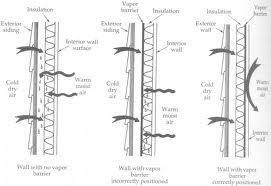Moisture Control
As seen in the Milwaukee Area

Moisture Control
The best strategy for controlling moisture in your home depends on your climate and how your home is constructed. Before deciding on a moisture control strategy for your home, you may first want to understand how moisture moves through a home.
Moisture control strategies typically include the following areas of a home:
Attics; Foundations; Basements; Crawl spaces; Slab-on-grade floors; Walls
In most U.S. climates, you can use vapor diffusion retarders in these areas of your home to control moisture. Proper ventilation should also be part of a moisture control strategy.
Combination Air Barriers/Vapor Diffusion Retarders
An air barrier/vapor diffusion retarder attempts to combine water vapor diffusion and air movement control with one material. This type of material is most appropriate for southern climates where keeping humid outdoor air from entering the building cavities is critical during the cooling season.
In many cases, air barriers/vapor diffusion retarders consist of one or more of the following materials:
Polyethylene Plastic Sheets
Builder’s Foil
Foam Board Insulation
Other Exterior Sheathings
A proper balance between all of these elements will also result in a more comfortable, healthier home environment.
How Moisture Moves Through a Home
To help understand the principles of moisture control, you need to understand the basics of how moisture can move through your home.
Moisture or water vapor moves in and out of a home in three ways:
Air Currents
Diffusion
Heat Transfer
Of these three, air movement accounts for more than 98% of all water vapor movement in building cavities. Air naturally moves from a high pressure area to a lower one by the easiest path possible—generally through any available hole or crack in the building envelope. Moisture transfer by air currents is very fast (in the range of several hundred cubic feet of air per minute). Thus, you need to carefully and permanently air seal any unintended paths to control air movement.
The other two driving forces—diffusion through materials and heat transfer—are much slower processes. Most common building materials slow moisture diffusion to a large degree, although they never stop it completely. Insulation also helps reduce heat transfer or flow.
The laws of physics govern how moist air reacts within various temperature conditions. The study of moist air properties is technically referred to as “psychrometrics.” A psychrometric chart is used by professionals to determine at what temperature and moisture concentration water vapor begins to condense. This is called the “dew point.” By understanding how to find the dew point, you will better understand how to avoid moisture problems in your house.
Relative humidity (RH) refers to the amount of moisture contained in a quantity of air compared to the maximum amount of moisture the air could hold at the same temperature. As air warms, its ability to hold water vapor increases; this capacity decreases as air cools. For example, according to the psychometric chart, air at 68ºF (20ºC) with 0.216 ounces of water (H2O) per pound of air (14.8g H2O/kg air) has a 100% RH. The same air at 59ºF (15ºC) reaches 100% RH with only 0.156 ounces of water per pound of air (10.7g H2O/kg air). The colder air holds about 72% less of the moisture as the warmer air. The moisture that the air can no longer hold condenses on the first cold surface it encounters (the dew point.) If this surface is within an exterior wall cavity, wet insulation and framing will be the result.
In addition to air movement, you also can control temperature and moisture content. Since insulation reduces heat transfer or flow, it also moderates the effect of temperature across the building envelope cavity. In most U.S. climates, properly installed vapor diffusion retarders can be used to reduce the amount of moisture transfer. Except in deliberately ventilated spaces, such as attics, insulation and vapor diffusion retarders work together to reduce the opportunity for condensation in a house’s ceilings, walls, and floors.
To effectively control moisture in your home, you need to first consider your climate when exploring your moisture control options.
Vapor Barriers or Vapor Diffusion Retarders

In most U.S. climates, vapor barriers or vapor diffusion retarders should be considered as part of a moisture control strategy for a home.
How They Work
A vapor barrier or vapor diffusion retarder (VDR) is a material that reduces the rate at which water vapor can move through a material. The older term “vapor barrier” is still used even though it may inaccurately imply that the material stops all of the moisture transfer. Since everything allows some water vapor to diffuse through it to some degree, the term “vapor diffusion retarder” is more accurate.
The ability of a material to retard the diffusion of water vapor is measured by units known as “perms” or permeability. A perm at 73.4°F (23°C) is a measure of the number of grains of water vapor passing through a square foot of material per hour at a differential vapor pressure equal to one inch of mercury (1″ W.C.) Any material with a perm rating of less than 1.0 is considered a vapor retarder.
Vapor diffusion retarders can help control moisture in these areas:
Basements
Ceilings
Floors
Slab-on-grade foundations
Walls
Crawl Spaces
Stopping Air is the Second Most Important Job of a Building Enclosure
Energy efficiency requires a tight shell and good indoor air quality. In “leaky” homes, large volumes of air — driven by exhaust fans, furnace fans, the stack effect, and wind — can blow through the home’s floor, walls, and ceiling. Because air usually contains water vapor, these uncontrolled air leaks can cause condensation. Homes needs an adequate air barrier and a controlled ventilation path.

